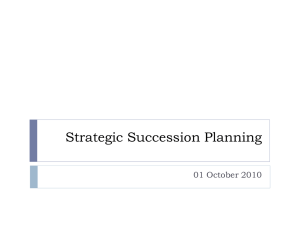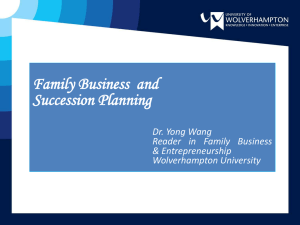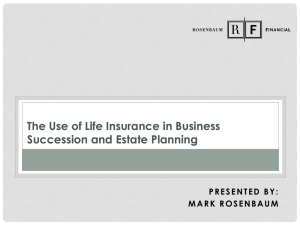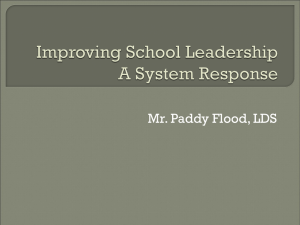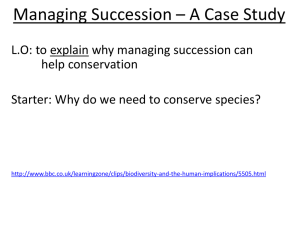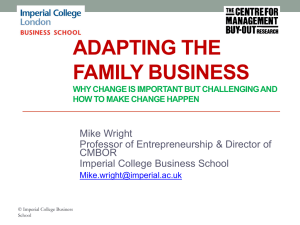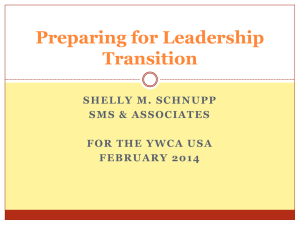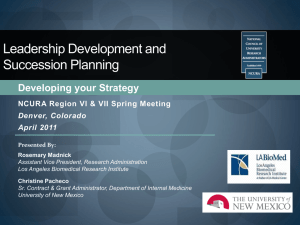John W. Edwards, Jr. Succession Planning Presentation
advertisement
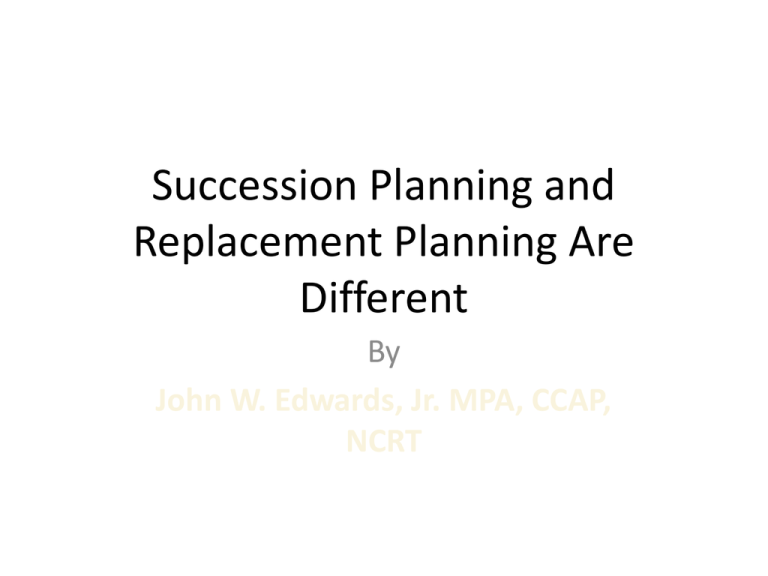
Succession Planning and Replacement Planning Are Different By John W. Edwards, Jr. MPA, CCAP, NCRT Replacement Planning (RP) • RP is an effort to respond to changes in the workplace that result in open positions that must be filled to allow the organization to continue to function effectively. Replacement Planning • RP is reactionary and is not forward-looking. It occurs at the point when a position becomes vacant . It involves an assessment of need based upon the job description, potential revisions to the job description or job requirements and the identification of areas where new employees might be recruited. Replacement Planning • RP is the process of identifying short-term and long-term emergency backups to fill critical positions or to take the place of critical people. • Short-term RP focuses on finding backups while a critical person is out for a short time, such as vacation or illness. Replacement Planning • Long-term RP focuses on finding backups to fill critical positions or to fill in for critical people when they become absent for long periods or for reasons of death, disability, sudden resignations. • Replacements should not necessarily mean people who will take a job forever; rather, they can meet the job requirements long enough for a search to occur. Replacement Planning • RP usually focuses on finding backups inside the organization. It usually works well in corporate cultures characterized by “silos”. • RP is a starting point for succession planning and talent management. • Common elements of successful RP programs follow: Replacement Planning 1. Gain management commitment to undertake the effort. 2. Clarify who – how many people – will be the focus of the RP effort. 3. Determine the focus of the RP effort should be. 4. Brief all personnel on how the RP process will work. Replacement Planning 5. Brief Managers on how to conduct RP process. 6. Identify and interview and select employees as candidates for RP program. 7. Develop and implement individual action plans. 8. Evaluate the results of the RP program periodically. Replacement Planning • RP is a reactive approach limited to identifying a replacement candidate for a specific employee at the top level of the organization with little focus on development of that candidate and an assumption that the incumbent is the model of the knowledge and skills needed to succeed in that position. Succession Planning • SP is a far more dynamic and proactive approach to succession that looks at the focused development of candidates for all critical positions within the organization, not just those in high level leadership positions, while relying on organizational strategy to define the knowledge and skills needed for success in each of the positions being considered. Succession Planning • SP is a process for identifying and developing internal people with the potential to fill key business leadership positions in the organization. It increases the availability of experienced and capable employees that are prepared to assume these roles as they become available. • Taken narrowly, RP for key roles is the start of SP. Succession Planning • Effective succession or talent-pool management concerns itself with building a series of feeder groups up and down the entire leadership pipeline. • RP, in contrast to SP, is focused narrowly on identifying specific back-up candidates for given senior management positions. • SP is a process whereby an organization ensures that employees are recruited and developed. Succession Planning • Through an effective SP process, organizations recruit superior employees, develop their knowledge, skills and abilities, and prepare them for advancement or promotion into even more challenging roles. • As organizations expand, lose key employees, provide promotional opportunities, add new programs, the SP process guarantees that you have employees to fill new roles. Succession Planning • “Bench Strength” remains a stubborn problem in many if not most non-profits and business too. • Research shows that non-profits and business that report greatest gains from SP feature high level of engagement of the CEO and its board of directors. • GE, Honeywell, IBM, Marriott, Microsoft, Pepsi, and Procter & Gamble are well known for SP practices. Succession Planning • Research indicates that clear core set of objectives are critical to establishing effective SP: 1. Identify those with the potential to assume greater responsibility in the organization. 2. Provide critical development experiences to those that can move into key roles. 3. Engage leadership in support. Succession Planning 4. Build a data base to use for better staffing decisions for key vacancies. 5. Improve employee commitment and retention. 6. Meet the career development expectations of existing employees 7. Counter the costs of recruiting employees externally. Succession Planning • SP: How To Do It Right Step one – Fully engage your stakeholders. Step two – Assess your internal candidates. Step three – Conduct a stress test and simulation. Step four – on-board the successor Boards of directors can – and must – plan an important role in SP. Succession Planning • Boards must be aggressive and unwavering in their efforts to make the process as real as possible. • Honest external evaluation of current talent and a system to develop a rich talent pipeline are essential for board engagement. • Board of directors need to design SP not just to choose the new executive but also to provide support as he/she finds legs. Succession Planning • Some Points to Ponder… 1. What is the average age of your employees? 2. What is your current process for indentifying employees with a high potential to take on leadership roles? 3. How do you today identify candidates who are maybe ready to step into key roles? Succession Planning 4. How do you ensure that you are training the right people for leadership roles and measuring them accordingly? 5. What if a key contributor or member of your executive team left unexpectedly? Succession Planning • A Practical Guide to CEO SP 1. Establish the foundation 2. Create a written SP 3. Conduct regular in-depth reviews 4. Compare the resulting list of capabilities against the firm’s senior talent pipeline 5. Implement the Plan Succession Planning The End
